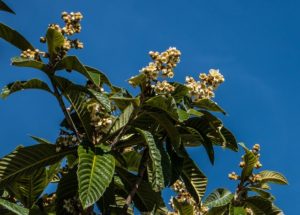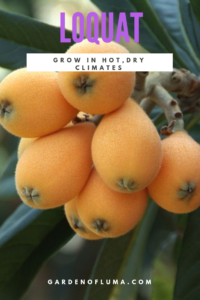How to Grow a Loquat Tree in Hot, Dry Climates

I had a chance to sample a Loquat off a tree from a local nursery. This was another one of those fruits that I had never even heard of until I began getting more entrenched in growing fruit trees. For us local gardeners, we joke around about how much of an addiction growing things can become, but it’s a good addiction. Back to the Loquat, I really enjoyed the taste of this fruit, but it took me a while to decide to purchase a tree of my own. Loquats are a sensitive tree in our hot, dry desert climate, especially when they’re young. I’ve seen a lot of Loquat causalities from beginner gardener’s Hopefully this post will help you learn some strategies to successfully grow a Loquat, even in extreme heat and dry climates.
Loquat Trees are very beautiful trees.
The leaves are large and have a tropical appearance to them.
Even without the fruit, Loquat tree leaves are popular for medicinal uses.
This tree grows great in temperate climates like San Diego or South Florida.
It can struggle a bit in drier, hot climates, but we still have quite a few fruiting Loquat trees around the Phoenix, Arizona area.
Bradenton Loquat
One of the local nurseries had a deal that was too good to pass up, so I decided to give growing a Loquat tree a chance.
I ended up selecting a variety called Bradenton, which is popular down in Florida.
There isn’t a ton of info on this variety, but from what I’ve been able to research, the fruit is of excellent quality.
I did discover that it is a bit more of a later season variety than some of the Loquats, so I’m hoping that won’t affect the fruit quality too much.
It was reportedly a vigorous grower, which I haven’t seen so much in my climate, but it is growing at a steady pace.
Fruit
The fruit is around the size of a ping-pong ball and reminds of a cross between a plum and an apricot.
It has a nice tangy, sweet and refreshing taste.
There are a few good sized seeds contained in the fruit.
Loquats fruit anywhere from Jan-June in the Phoenix area depending on the variety.
The Loquat tree typically starts blooming in the winter.
The blossoms are very fragrant reminiscent of citrus blossoms or lilacs.

Gardening Skill Level
I would rate growing Loquat trees in hot, dry climate as moderate skill level.
The challenge is getting them through the first few years in a hot, dry climate.
Once the tree has become more established and built up a strong root system, than the tree is more manageable.

Suitable for Container Growing
Loquat tree can stay manageable in a container.
With that being said, since they struggle so much when temps are too high, I’d recommended avoiding growing a Loquat tree in a container.
If you are in a climate that doesn’t stay over triple digits on a regular basis and you can keep the roots fairly cool you could give it a try.
As I recommend for most fruit trees in containers, you want to ensure that you have good drainage and a soil like a cactus mix that won’t retain too much moisture.
Planting Tips
The main thing to consider when planting a Loquat tree in hot, dry climates is to ensure it has the proper microclimate to give it sufficient shade.
Loquats can take a decent amount of cold, so as long as you’re in a climate that stays fairly warm through the winter, you don’t need to worry about cold protection.
The blossoms can’t take quite as much cold, but otherwise, the tree can cruise right on through our winters in Zone 9b.
Watering
Loquats like a steady amount of water, so I never let the root zone completely dry out.
Loquats aren’t known to be drought tolerant.
They also have larger leaves which transpire more moisture which can cause the tree to need more consistent watering.
I try to give the tree a good deep soak a few times a week during the hottest parts of the year.
Feeding

Loquats can show some deficiencies in our high PH soil.
I tend to use soil sulfur throughout the year to help bring the PH down a bit.
I also use Epsom Salt once a month during the hotter months of the year to help with some of the mineral deficiencies.
Otherwise, I feed as usual with periodic applications of compost, fish emulsion, and liquid seaweed.
Here are some of my recommended products that I use.
Sun Exposure
Shade is a must for Loquat trees in hot, dry climates with temps over 100 degrees Fahrenheit.
I have created a structure around the tree using tall wooden stakes and have 80% shade cloth over the top of the structure.
If you have a microclimate in your yard that has a lot of shade throughout the day, that will be a good spot for your Loquat tree.
Loquats can take a bit more sun when established, but still aren’t trees that should be planted in full sun in a hot, dry environment.
The leaves tend to scorch very easily from too much intense sun.
Potential Problems
Loquat trees don’t really attract too many pest problems.
The main problem is that the leaves can burn from too much sun or lack of nutrients.
If following the proper feeding procedures and utilizing the right microclimate as previously discussed, it’ll increase your chance of successfully growing a Loquat Tree in hot, dry climates.
Please comment below on anything you enjoyed from this post or your experience with growing Loquat trees in hot, dry climates.

Thank you so much for this information, I am addicted to plant, recently i purchased a Loquat plant from Northern areas of Pakistan and I am living In Sindh where temperature goes up to 48c in June and July. I have 80% net shed and I am misting on it daily. I will give a wooden structure around it so that can resist heat of marble.